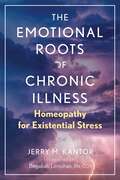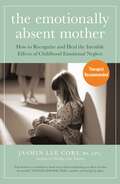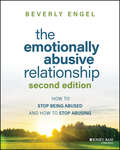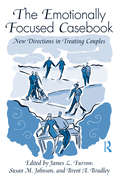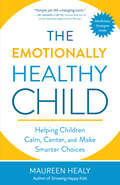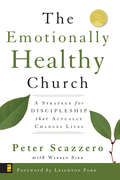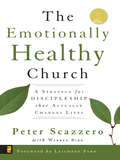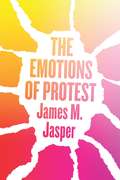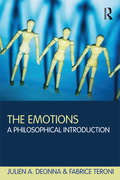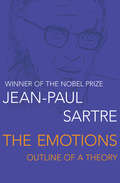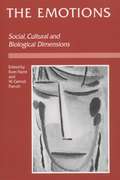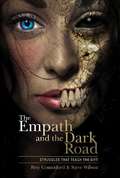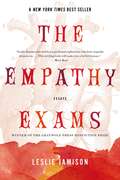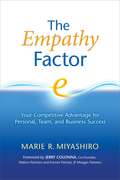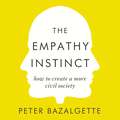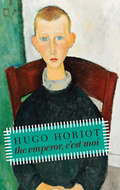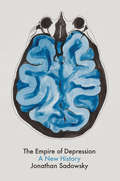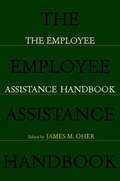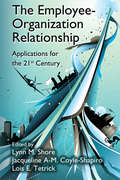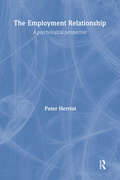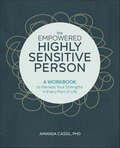- Table View
- List View
The Emotional Politics of Racism: How Feelings Trump Facts in an Era of Colorblindness
by Paula IoanideWith stop-and-frisk laws, new immigration policies, and cuts to social welfare programs, majorities in the United States have increasingly supported intensified forms of punishment and marginalization against black, Latino, Arab and Muslim people in the United States, even as a majority of citizens claim to support "colorblindness" and racial equality. With this book, Paula Ioanide examines how emotion has prominently figured into these contemporary expressions of racial discrimination and violence. How U. S. publics dominantly feel about crime, terrorism, welfare, and immigration often seems to trump whatever facts and evidence say about these politicized matters. Though four case studies--the police brutality case of Abner Louima; the exposure of torture at Abu Ghraib; the demolition of New Orleans public housing units following Hurricane Katrina; and a proposed municipal ordinance to deny housing to undocumented immigrants in Escondido, CA--Ioanide shows how racial fears are perpetuated, and how these widespread fears have played a central role in justifying the expansion of our military and prison system and the ongoing divestment from social welfare. But Ioanide also argues that within each of these cases there is opportunity for new mobilizations, for ethical witnessing: we must also popularize desires for justice and increase people's receptivity to the testimonies of the oppressed by reorganizing embodied and unconscious structures of feeling.
The Emotional Roots of Chronic Illness: Homeopathy for Existential Stress
by Jerry M. KantorHow to change the subconscious patterns underlying chronic conditions• Explains how to use prominent emotional and physical symptoms to determine the core existential stress underlying one&’s chronic condition • Introduces five, seminal existential questions correlating with both the five miasms of homeopathy and the Five Phases of Chinese Medicine • Presents homeopathic remedies connected to specific existential quandaries and explains their indications through detailed examples from the author&’s practice In addition to working well for purely physical ailments, homeopathy offers remedies for engaging directly with the subconscious mind and ameliorating embedded, existential causes of chronic illness—called &“miasms&” in classical homeopathy. Presenting diagnostic insight, specific homeopathic remedies, and successful case study examples about the profound connections between emotions and their physical manifestations in illness, Jerry M. Kantor correlates the five classical miasms and their core existential quandaries with the Five Elements and Phase Theory of Chinese Medicine. He likens inborn foundational emotions to tools, each one designed to solve a stress-related problem. Self-sabotaging imbalances—energetic and physical—can occur when an emotional tool is excessively used, such as when a once-familiar stress is no longer present, or underused, as when a stressful input is inadequately managed. He explains how identifying a default emotional response—such as anxiety or anger—along with its accompanying physical symptoms can determine the core existential stress or heredity pattern underlying a chronic condition. For each of the five classical miasms and their associated physical and emotional conditions, the author presents homeopathic remedies that mollify the impact of specific existential quandaries and explains their indications through detailed examples from his practice. Revealing that the subconscious mind is amenable to change, Kantor shows how to accurately select remedies to defuse the energetic charge of unresolved existential stress and thus quell the root causes of chronic illness.
The Emotionally Absent Mother: How to Recognize and Heal the Invisible Effects of Childhood Emotional Neglect
by Jasmin Lee CoriTHE GROUNDBREAKING GUIDE TO SELF-HEALING, AND GETTING THE LOVE YOU MISSED'Years ago, I was on vacation and read The Emotionally Absent Mother. That book was one of many that woke me up... I began the process of reparenting and it's changed my life.' Dr. Nicole LePera, New York Times-bestselling author of How to Do the WorkWas your mother preoccupied or distant? Did she regularly demean you? Have you struggled with relationships - or with your own self-worth? Often, the grown children of emotionally absent mothers can't quite put a finger on what's missing from their lives. The children of abusive mothers, by contrast, may recognize the abuse - but overlook its lasting, harmful effects.Psychotherapist Jasmin Lee Cori has helped thousands of women and men heal the hidden wounds left by every kind of undermothering. In the second edition of this pioneering book, with compassion for mother and child alike, she explains:- Possible reasons your mother was distracted or hurtful - and what she was unable to give- The lasting impact of childhood emotional neglect and abuse- How to find the child inside you and fill the 'mother gap' through reflections and exercises- How to secure a happier future for yourself - How to break free from the pattern of neglect and abuse with children you have now or may have in the future.
The Emotionally Abusive Relationship: How to Stop Being Abused and How to Stop Abusing
by Beverly EngelA step-by-step guide to help both victims of emotional abuse and their abusers escape unhealthy patterns originating from childhood abuse and neglect In the second edition of The Emotionally Abusive Relationship: How to Stop Being Abused and How to Stop Abusing, internationally recognized therapist Beverly Engel walks readers through a proven program designed to help readers get to the core of their unhealthy behavior patterns. This book was written specifically for two types of couples—those who mutually abuse each other and those with abusive partners who are willing to honestly look at themselves to and make the necessary changes to stop abusing. Unique among books of this type, Engel focuses on both the abused person and the abuser, offering non-judgmental advice to both groups. She offers effective strategies, techniques, and information to end abusive behaviors, including: Why some people are attracted to abusive people and vice versa Patterns created from childhood neglect and abuse and how to break them Determining if you or your partner suffers from a personality disorder such as Narcissism or Borderline Personality Disorder How to decide whether to continue the relationship or end it The importance of healing shame caused by childhood neglect and abuse How self-compassion can help heal both victims of emotional abuse and the abusers themselvesThe Emotionally Abusive Relationship is essential for those involved in unhealthy relationships or who have loved ones trapped in an emotionally abusive situation. Therapist recommended, this book is also a must-read resource for students of psychotherapy.
The Emotionally Focused Casebook: New Directions in Treating Couples
by Susan M. Johnson James L. Furrow Brent A. BradleyThere is currently no single resource that compiles the various applications to the many clinical populations being served by Emotionally Focused Therapy today. The Emotionally Focused Casebook fills that void as a substantive reference for clinicians, students, professors, and supervisors using and teaching EFT. Each chapter utilizes a hands-on case study approach with concrete guidelines and illustrations for the adaptation and application of EFT with specific treatment populations. This Casebook is the perfect practical resource for professionals and students looking for examples of specific theoretical, conceptual, and treatment applications of EFT.
The Emotionally Healthy Child: Helping Children Calm, Center, and Make Smarter Choices
by Maureen HealyWinner of Nautilus Book Award in Parenting & FamilyWhile growing up has never been easy, today&’s world presents kids and their parents with unprecedented challenges. The upside, posits Maureen Healy, is a widespread acknowledgment that emotional health, resilience, and equilibrium can be learned and strengthened. Healy is an expert on teaching skills that address the high sensitivity, big emotions, and hyper energy she herself experienced growing up. Three simple steps are key — Stop, Calm, and Make Smarter Choices. While not always easy, these steps are powerful, and Healy shows readers exactly how to implement them. Children move from acting out or shutting down, experiencing frequent physical symptoms such as head- and stomachaches, or hurting themselves or others, to recognizing they are being triggered, feeling their emotions, and using mindfulness strategies to respond from a calmer place.
The Emotionally Healthy Church
by Peter Scazzero Warren BirdTrue Discipleship Integrates Emotional and Spiritual Health. New Life Fellowship in Queens, New York, had it all: powerful teaching, dynamic ministries, an impressive growth rate, and a vision to do great works for God. Things looked good-but beneath t
The Emotionally Healthy Church
by Peter Scazzero Warren BirdDiscover exactly what it takes for the truth to set people free. This revised and expanded edition of Peter Scazzero's award-winning book not only takes the original six principles for cultivating spiritual and emotional health in a church further and deeper, but he also adds a seventh principle to show church leaders how to slow down to lead with integrity.
The Emotions of Protest
by James M. JasperIn Donald Trump’s America, protesting has roared back into fashion. The Women’s March, held the day after Trump’s inauguration, may have been the largest in American history, and resonated around the world. Between Trump’s tweets and the march’s popularity, it is clear that displays of anger dominate American politics once again. There is an extensive body of research on protest, but the focus has mostly been on the calculating brain—a byproduct of structuralism and cognitive studies—and less on the feeling brain. James M. Jasper’s work changes that, as he pushes the boundaries of our present understanding of the social world. In The Emotions of Protest, Jasper lays out his argument, showing that it is impossible to separate cognition and emotion. At a minimum, he says, we cannot understand the Tea Party or Occupy Wall Street or pro- and anti-Trump rallies without first studying the fears and anger, moral outrage, and patterns of hate and love that their members feel. This is a book centered on protest, but Jasper also points toward broader paths of inquiry that have the power to transform the way social scientists picture social life and action. Through emotions, he says, we are embedded in a variety of environmental, bodily, social, moral, and temporal contexts, as we feel our way both consciously and unconsciously toward some things and away from others. Politics and collective action have always been a kind of laboratory for working out models of human action more generally, and emotions are no exception. Both hearts and minds rely on the same feelings racing through our central nervous systems. Protestors have emotions, like everyone else, but theirs are thinking hearts, not bleeding hearts. Brains can feel, and hearts can think.
The Emotions: A Philosophical Introduction
by Fabrice Teroni Julien DeonnaThe emotions are at the centre of our lives and, for better or worse, imbue them with much of their significance. The philosophical problems stirred up by the existence of the emotions, over which many great philosophers of the past have laboured, revolve around attempts to understand what this significance amounts to. Are emotions feelings, thoughts, or experiences? If they are experiences, what are they experiences of? Are emotions rational? In what sense do emotions give meaning to what surrounds us? The Emotions: A Philosophical Introduction introduces and explores these questions in a clear and accessible way. The authors discuss the following key topics: the diversity and unity of the emotions the relations between emotion, belief and desire the nature of values the relations between emotions and perceptions emotions viewed as evaluative attitudes the link between emotions and evaluative knowledge the nature of moods, sentiments, and character traits. Including chapter summaries and guides to further reading, The Emotions: A Philosophical Introduction is an ideal starting point for any philosopher or student studying the emotions. It will also be of interest to those in related disciplines such as psychology and the social sciences.
The Emotions: Outline of a Theory
by Jean-Paul SartreOne of the leading twentieth-century French existentialist philosophers examines how human emotions shape our existence. In The Emotions: Outline of a Theory, French philosopher Jean-Paul Sartre attempts to understand the role emotions play in the human psyche. Sartre analyzes fear, lust, anguish, and melancholy while asserting that human beings begin to develop emotional capabilities from a very early age, which helps them identify and understand the emotions&’ names and qualities later in life. Helping to complete the circle of Sartre&’s many theories on existentialism, this vital piece of literature is a must-have for the philosopher-in-training&’s collection.
The Emotions: Outline of a Theory
by Jean-Paul SartreOne of the leading twentieth-century French existentialist philosophers examines how human emotions shape our existence. In The Emotions: Outline of a Theory, French philosopher Jean-Paul Sartre attempts to understand the role emotions play in the human psyche. Sartre analyzes fear, lust, anguish, and melancholy while asserting that human beings begin to develop emotional capabilities from a very early age, which helps them identify and understand the emotions&’ names and qualities later in life. Helping to complete the circle of Sartre&’s many theories on existentialism, this vital piece of literature is a must-have for the philosopher-in-training&’s collection.
The Emotions: Social, Cultural and Biological Dimensions (The\law And Public Policy Ser.)
by Professor Rom Harre W Gerrod ParrottThis fascinating book overviews the psychology of the emotions in its broadest sense, tracing historical, social, cultural and biological themes and analyses. The contributors - some of the leading figures in the field - produce a new theoretical synthesis by drawing together these strands. <p><p> From the standpoint of the function of the emotions in everyday life, the authors focus on: the discursive role played by the emotions in expressing judgements about, attitudes to and contrition for actions done by the self and others, and how certain emotions - such as guilt, shame, embarrassment, chagrin and regret - seem to play a role in social control; the variation and diversity in emotion, which provides scope for exploring how patterns of emotion contrast in different societies, across gender lines, at different historical times, and between children and adults; and the way in which the body is shaped and its functions influenced by culturally maintained patterns of emotion displays.
The Empath and the Dark Road: Struggles that Teach the Gift
by Steve Wilson Bety ComerfordDo you feel a victim of your emotions? Of others' emotions? Does life constantly throw you a curve ball no matter what you do? Do you wear your heart on your sleeve as a loving, caring person, yet the darker aspects of life make you feel as though you've been cursed? If so, then this book is for you. Embark upon an empathic journey that teaches you that darkness is but an absence of light. Who's light? Your light. Learn that you are in control of your emotional experiences. Begin to understand what it means to be an empath who chooses to live a life devoid of drama and free from the projected emotional pain from others. Discover methods to help you rise above the darkness that surrounds you--not only the darkness given to you by others, but from that which lies within you. This is the authors' fourth book on the empathic experience.
The Empathy Exams: Essays
by Leslie JamisonFrom personal loss to phantom diseases, a bold and brilliant collection, winner of the Graywolf Press Nonfiction Prize<P> Beginning with her experience as a medical actor who was paid to act out symptoms for medical students to diagnose, Leslie Jamison’s visceral and revealing essays ask essential questions about our basic understanding of others: How should we care about each other? How can we feel another’s pain, especially when pain can be assumed, distorted, or performed? Is empathy a tool by which to test or even grade each other? By confronting pain—real and imagined, her own and others’—Jamison uncovers a personal and cultural urgency to feel. She draws from her own experiences of illness and bodily injury to engage in an exploration that extends far beyond her life, spanning wide-ranging territory—from poverty tourism to phantom diseases, street violence to reality television, illness to incarceration—in its search for a kind of sight shaped by humility and grace.
The Empathy Factor: Your Competitive Advantage for Personal, Team, and Business Success
by Marie R. MiyashiroBuilding on the latest research in brain science, emotional intelligence, and organizational theory, an award-winning communication and organizational strategist answers questions about the true definition of empathy. This groundbreaking exploration into business productivity and office management offers both real-world insights and practical ways to build transformative empathy skills organization-wide. It shows how learning about and teaching empathy in the workplace can improve productivity, innovation, and profitability. The guide also provides an innovative framework to help leaders meet the six universal needs of the organization itself while also respecting those of individual employees and customers.
The Empathy Instinct: How to Create a More Civil Society
by Peter Bazalgette'If we hope to meet the moral test of our times, then I think we're going to have to talk more about the "empathy deficit". The ability to put ourselves in somebody else's shoes, to see the world through somebody else's eyes . . .' Barack ObamaEmpathy is the power of understanding others, imaginatively entering into their feelings. It is a fundamental human attribute, without which mutually co-operative societies cannot function. In a revolutionary development, we now know who has it, who lacks it and why. Via the MRI scanner we are mapping the human brain. This is a new frontier that reveals a host of beneficial ideas for childcare, teens challenged by the internet, the justice system, decent healthcare, tackling racism and resolving conflicts. In this wide-ranging and accessible book full of entertaining stories that are underlined by the latest scientific research, Peter Bazalgette also mounts a passionate defence of arts and popular culture as a means of bridging the empathy gap. As the world's population expands, consuming the planet's finite resources, as people haunted by poverty and war are on the move and as digital communications infinitely complicate our social interactions, we find our patience and our sympathy constantly challenged. Here is the antidote.Culminating in a passionate manifesto on empathy, The Empathy Instinct is what makes us human and what can make us better humans.
The Empathy Instinct: How to Create a More Civil Society
by Peter BazalgetteEmpathy is the power of understanding others, imaginatively entering into their feelings. It is a fundamental human attribute, without which mutually co-operative societies cannot function. In a revolutionary development, we now know who has it, who lacks it and why. Via the MRI scanner we are mapping the human brain. This is a new frontier that reveals a host of beneficial ideas for childcare, teens challenged by the internet, the justice system, decent healthcare, tackling racism and resolving conflicts. In this wide-ranging and accessible book full of entertaining stories that are underlined by the latest scientific research, Peter Bazalgette also mounts a passionate defence of arts and popular culture as a means of bridging the empathy gap. As the world's population expands, consuming the planet's finite resources, as people haunted by poverty and war are on the move and as digital communications infinitely complicate our social interactions, we find our patience and our sympathy constantly challenged. Here is the antidote.Culminating in a passionate manifesto on empathy, The Empathy Instinct is what makes us human and what can make us better humans.(P)2017 John Murray Press
The Emperor's New Drugs: Exploding the Antidepressant Myth
by Irving KirschDo antidepressants work? Of course--everyone knows it. Like his colleagues, Irving Kirsch, a researcher and clinical psychologist, for years referred patients to psychiatrists to have their depression treated with drugs before deciding to investigate for himself just how effective the drugs actually were. Over the course of the past fifteen years, however, Kirsch’s research--a thorough analysis of decades of Food and Drug Administration data--has demonstrated that what everyone knew about antidepressants was wrong. Instead of treating depression with drugs, we’ve been treating it with suggestion. The Emperor’s New Drugs makes an overwhelming case that what had seemed a cornerstone of psychiatric treatment is little more than a faulty consensus. But Kirsch does more than just criticize: he offers a path society can follow so that we stop popping pills and start proper treatment for depression.
The Emperor, C'est Moi
by Linda Coverdale Hugo HoriotHugo Horiot is in love with wheels and all that cranks or turns. He is obsessed with the otherworldly language of pipes--they run, he imagines, from his family home to the center of the earth. He causes endless trouble at home and hates school. He muses: "I dream asleep, I dream awake"--but he dreams so hard he shuts out the world with reveries that are not just curious but dangerous and painful too. School is a prison he must escape, his teachers oppressors, and his classmates "a band of jolly torturers." This is the portrait of a boy who might happen to suffer from autism, but who is also a beautiful rebel inspired to blaze his own path through childhood to find an enduring sense of personal freedom.From the Hardcover edition.
The Empire of Depression: A New History
by Jonathan SadowskyDepression has colonized the world. Today, more than 300 million of us have been diagnosed as depressed. But 150 years ago, “depression” referred to a mood, not a sickness. Does that mean people weren’t sick before, only sad? Of course not. Mental illness is a complex thing, part biological, part social, its definition dependent on time and place. But in the mid-twentieth century, even as European empires were crumbling, new Western clinical models and treatments for mental health spread across the world. In so doing, “depression” began to displace older ideas like “melancholia,” the Japanese “utsushō,” or the Punjabi “sinking heart” syndrome. Award-winning historian Jonathan Sadowsky tells this global story, chronicling the path-breaking work of psychiatrists and pharmacists, and the intimate sufferings of patients. Revealing the continuity of human distress across time and place, he shows us how different cultures have experienced intense mental anguish, and how they have tried to alleviate it. He reaches an unflinching conclusion: the devastating effects of depression are real. A number of treatments do reduce suffering, but a permanent cure remains elusive. Throughout the history of depression, there have been overzealous promoters of particular approaches, but history shows us that there is no single way to get better that works for everyone. Like successful psychotherapy, history can liberate us from the negative patterns of the past.
The Employee Assistance Handbook
by James M. OherThis Handbook provides clinicians, administrators, and human resource professionals with a comprehensive review of EAP "best practices." Experts from the employee assistance field, behavioral health organizations, and corporate sectors illustrate the unique role EAPs play in maintaining a vibrant and productive workforce and explain the skills and resources needed to provide effective EAP services.
The Employee-Organization Relationship: Applications for the 21st Century (Applied Psychology Series)
by Lois E. Tetrick Lynn M. Shore Jacqueline A-M. Coyle-Shapiro"Employee-organization relationship" is an overarching term that describes the relationship between the employee and the organization. It encompasses psychological contracts, perceived organizational support, and the employment relationship. Remarkable progress has been made in the last 30 years in the study of EOR. This volume, by a stellar list of international contributors, offers perspectives on EOR that will be of interest to scholars, practitioners and graduate students in IO psychology, business and human resource management.
The Employment Relationship: A Psychological Perspective
by Peter HerriotThe Employment Relationship presents a controversial perspective on an area hitherto dominated by industrial relation experts and radical sociological theorists. Exploring some of the metaphors commonly used to describe the employment relationship, Peter Herriot argues that it is often their dark rather than their bright side which best expresses how employees really feel. Human resources sometimes feel like human discards! The main culprits in this situation, he suggests, are the top managers who fail to treat employment as a relationship and employees as individuals. He concludes that management rhetoric must be replaced by real dialogue and points to three issues where this is most crucial: employee compliance, contractual inequalities and the need for organisational change. The Employment Relationship will make essential reading for all managers and occupational psychologists. It will also be of interest to students of work psychology, human resource management or organisational behaviour.
The Empowered Highly Sensitive Person: A Workbook to Harness Your Strengths in Every Part of Life
by Amanda CassilBecome a highly empowered, highly sensitive person with practical strategies and exercisesDo you experience more emotional intensity than others? Do you tend to be more easily overstimulated or process information more slowly? You may be an empath or a highly sensitive person (HSP). Functioning in a world not made for your sensibilities can be overwhelming, but The Empowered Highly Sensitive Person is full of practical, research-based exercises to help. With this workbook, you can understand and leverage your qualities as a highly sensitive person for success—no matter what life throws your way.Discover everyday strategies to cope with overstimulation, process intense emotions, curate your experiences and environment, communicate effectively, and practice good self care. Learn to harness your individual HSP characteristics in a way that aligns with your goals. Once you put your high sensitivity into perspective, you can truly get to know yourself.The Empowered Highly Sensitive Person includes:Support for all aspects of life—Exercises are targeted for social situations, relationships, health, or work, so you can find what you need right away.A guide to HSP traits—Get to know your HSP characteristics with in-depth examination and an at-a-glance checklist of the four principles of the HSP trait.Quick reference guides—Find succinct summaries of each chapter so you can easily revisit their themes and be reminded of what you've learned.Blossom and thrive as a highly sensitive person—this book has the tools you'll need.

